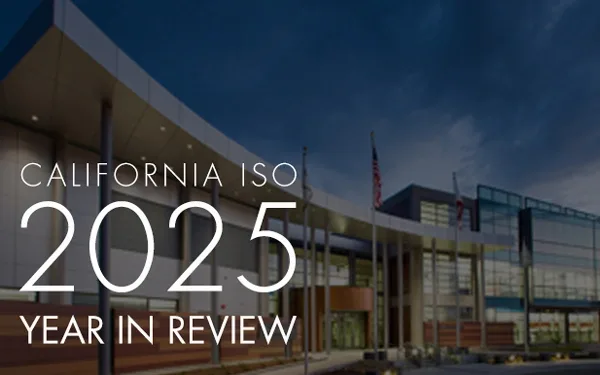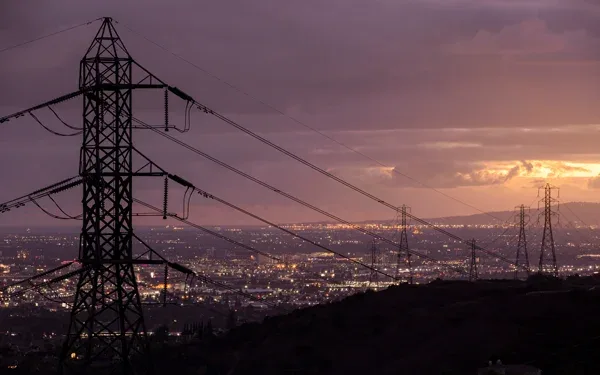California ISO 2023 Year in Review


Greetings Everyone,
This “California ISO 2023 Year in Review” provides an overview of our key accomplishments during 2023 as we continue to carry out the objectives of our 2022-2026 Strategic Plan.
The past year was a productive and impactful time for the California ISO. Through collaboration and coordination with our partners and stakeholders in California and the West, many positive steps were taken to improve reliability and make the electrical grid more resilient and better positioned to integrate all the new clean energy resources being added to the system.
We are proud of our shared accomplishments in 2023 and know there is more work ahead. Collaboration with our partners and stakeholders helps us all do a better job meeting the energy needs of the people of California and throughout the Western United States.
I hope you can take the time to read the Year in Review and share a link from our Energy Matters Blog with your colleagues and contacts. I look forward to continue working together in 2024 and beyond to reach our reliability and sustainability goals. On behalf of the entire California ISO, we wish you a happy holiday season and a healthy and peaceful New Year.
Last year, following extensive engagement with our partners and stakeholders, the California ISO published its 2022-2026 Strategic Plan, articulating our top strategic and tactical objectives to help guide the organization’s priorities and external efforts over the next five years.
With the first full year under the plan coming to an end, I am pleased to note that 2023 has seen solid progress on those objectives. We were able to produce results enhancing power system reliability while better positioning the ISO for continued success.
Working with our governing entities and partners and stakeholders in California and the West, we maintained system reliability throughout the summer, planned and approved billions of dollars in transmission upgrades, on-boarded thousands of megawatts of new clean generating capacity, made significant progress on plans to expand Western electricity markets and provide additional consumer and environmental benefits, improved customer service and stakeholder engagement, advanced our multi-year control center modernization initiative and more.
Looking back on the past year, I thought it would be useful to reflect on it through the framework of our Strategic Plan and the vision and critical objectives that shape it.
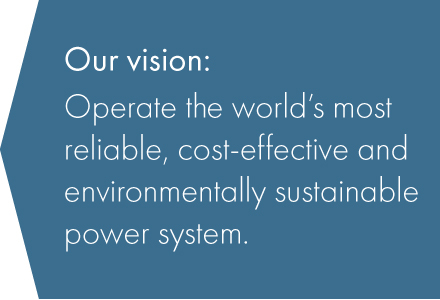
For the ISO, everything starts with reliability — being able to efficiently manage the grid so our operators can keep the lights on as our power system faces unprecedented challenges. The most significant challenges of 2023 again came during summer, as usually happens in California and the West when the weather heats up and demand for electricity peaks.
Because thousands of megawatts of new battery storage and other resources have been added to the grid the past several years — and with strong California hydro conditions — we went into summer 2023 better positioned than the last several years. And summer conditions were generally manageable this year, with relatively modest loads and temperatures in California compared to 2022. It was only during three days in late July — when extreme heat in parts of the West outside California drove challenging and fast-moving market dynamics — that we experienced strained grid conditions on the ISO system. Making adjustments and deploying additional resources as necessary, we worked through those events with no disruptions in service or Flex Alerts urging Californians to conserve electricity.

We issued a comprehensive report on the July events that detailed the lessons learned about grid conditions, resource performance and commercial scheduling practices. We adopted several changes in response to those learnings and actively communicated them to market participants. When warmer temperatures hit California in mid-August along with extreme heat in other parts of the West, we were able to deploy all of our tools — the day-ahead market and hour-ahead scheduling process, the Western Energy Imbalance Market (WEIM) and the Reliability Coordinator function — to support reliability across the broader interconnection. This was another clear demonstration of the tremendous value of transmission connectivity and resource diversity that exists between California and the broader region.
The reliability benefits of enhanced coordination and collaboration with partners in California and the region was driven home again on October 14 with the partial solar eclipse that passed across California and the West. With advanced planning and communication by our forecast and operations teams — internally and with neighboring balancing authorities — grid operators successfully managed the rapid loss and return of solar power. Normal system operations resumed shortly after the conclusion of the eclipse at 11:05 a.m. Pacific Time.
A strong foundation of resource adequacy is the underpinning of a reliable, cost-effective and environmentally sustainable power system. With more resources being added through the California Public Utilities Commission’s (CPUC) increased procurement orders and the actions of load-serving entities within our footprint, we expect to continue bolstering reliability as we strive to meet our broader vision.
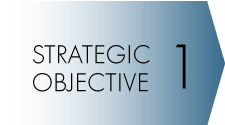
Reliably and efficiently integrate new resources by proactively upgrading operational capabilities.
As California accelerates its pace for adding new sources of clean power to the grid, it is essential for the ISO to continue upgrading the operational and technological capabilities needed to keep up and maintain maximum efficiency and reliability. That’s why in 2022 we kicked off our multi-year Control Center Foundational Improvement and Modernization initiative under Strategic Objective 1.
After a strong cross-divisional team identified improvements needed to strengthen our foundational capabilities for technology, training, people and processes, our teams began work on a diverse set of 40 work streams which successfully delivered a series of enhancements in 2023 that improved performance issues and application functions, with many more planned for 2024. Highlights include:
- Upgrading data, software, and modeling to increase operator awareness of normal and abnormal system conditions, while also improving analytical tools that help us operate reliably;
- Enhancing critical generation control and market systems to improve operator efficiency and resource management capabilities;
- Improving outage management tools to help operators in California and around the Western Interconnection more effectively manage transmission and generation outages;
- Improving how system, software, and data changes are managed, including upgraded software delivery processes, enhanced user acceptance testing, and enhanced internal and external change coordination and communications.
Next year, we will improve the control room video wall and further upgrade operator displays to reduce information overload and strengthen the new resource on-boarding process to ensure that new resources are fully prepared when they begin operations.

We have also been busy on the personnel side of the control center. After challenges the past several years with control room staffing levels, ratification of our first union contract with the International Brotherhood of Electrical Workers Local 1245 in February and stepped up recruitment efforts have better enabled us to attract and retain employees. And to address the large increase in operators attending training, we are expanding our operations training rooms and simulator, which will nearly quadruple the number of employees in training each week.
We have also been moving forward on other priorities associated with Strategic Objective 1. We have, for example, again successfully integrated significant amounts of new generating capacity onto the system over the past year. As of the first week in December, total online generating capacity added in 2023 was 4,180 megawatts (MW). Battery storage makes up more than half that total of new online capacity, bringing the overall capacity from batteries on the system to 6,675 MW — more than a ten-fold increase over the past three years. Our ability to efficiently integrate this rapidly growing fleet of storage resources into system operations made a major contribution to grid reliability in 2023.
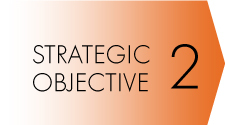
Strengthen resource adequacy and meet California’s SB 100 goals through long-term transmission planning and effective coordination with state agencies
Adding such large amounts of power to the grid has provided a significant boost to resource adequacy. Just as important, of course, is making sure we have the necessary transmission infrastructure to move power from where it’s generated to where it’s used. A lot was accomplished on this front in 2023.

Working closely with our partners at the CPUC, the California Energy Commission (CEC), and other local regulatory authorities, we adopted a new more proactive, strategic and zonal approach to transmission planning. In May, the Board of Governors unanimously approved the 2022-23 Transmission Plan, recommending 45 projects for transmission upgrades and expansions. Estimated cost of the projects at completion over the next decade or so: $7.3 billion.
The plan is noteworthy for more than just the sheer amount of infrastructure it will facilitate. Following through on the Memorandum of Understanding the ISO signed in December 2022 with the CPUC and CEC, our more proactive approach better synchronizes power and transmission planning, interconnection queuing and resource procurement. Among other things, the plan identifies additional transmission and resource capacity associated with designated geographic areas — both in California and throughout the West - that make the most economic and operational sense for such development. The CPUC will in turn provide clear direction to load-serving entities to focus energy procurement in those key interconnection areas in alignment with the transmission plan.
Another important step for making sure we have the necessary transmission to meet the growing demand for electricity in California and the West has been the ISO’s new Subscriber Participating Transmission Owner model approved by the Board in July. Under this model, TransWest Express plans to build a 732-mile combined high voltage direct current and alternating current transmission line with the potential to bring up to 3,000 MW of clean Wyoming wind power into California and other states in the Desert Southwest as early as 2027.
If approved by the Federal Energy Regulatory Commission (FERC), the subscriber model can enable new transmission lines outside the ISO balancing area for developers wanting to build and place transmission facilities under ISO operational control while using those facilities to connect generation to the ISO grid. Transmission to connect such generation, financed through the subscriber process approved by FERC, would be outside the revenue requirement of the ISO’s transmission access charge.
We are confident the new model, which would facilitate delivery of critically needed resources to the ISO grid, can apply more broadly in the West on future projects. Those would include some of the transmission needed to accommodate more than 4.5 gigawatts of wind generation from Idaho, Wyoming, and New Mexico identified in the CPUC resource planning portfolios and addressed through recent transmission approvals in the ISO’s 2022-2023 transmission plan. This would help enable more timely and efficient subscription and energization of new lines.
We have also been working with Idaho Power and LS Power on a joint effort for the Southwest Intertie Project-North (SWIP North), a 500 kV transmission line proposed from Midpoint Idaho to Robinson Summit that also requires upgrades to the NV Energy ON Line and Robinson Summit substation. Coupled with an existing capacity sharing agreement LS Power has in place with NV Energy, this project will allow the ISO to access more than 1,100 MW of wind resources from Idaho to the existing ISO network reaching to Harry Allen Nevada, and more than 500 MW of capacity from Harry Allen north to Idaho. The proposal is up for approval at the Board’s December meeting, conditioned on the continued support of the CPUC and ongoing participation by Idaho Power.
Our work on SWIP North has been driven by California’s resource planning and the interest in renewable resources in Idaho. The line would also provide another piece of important connectivity between California and Nevada and the Columbia River Plateau. These and other projects we have been advancing will provide additional reliability, resilience and economic value for California and the West.
When it comes to resource adequacy, notwithstanding all the progress that has been made in adding generating capacity — and to keep pace with the shifting energy landscape and changing climate — the ISO initiated a stakeholder-guided working group and initiative in 2023. Its goal: to identify how best to enhance our resource adequacy rules and procedures embedded in the ISO’s open-access tariff.
Published in September, our RA Working Group Discussion Paper identified three proposed problem statements to help focus our work on:
- More transparent and timely information on resource sufficiency and expected performance;
- Updating the ISO’s current requirements for RA capacity and program tools in light of evolving market and regulatory structures;
- A transparent and common framework for evaluating reserve margins and counting rules and understanding of a local regulatory RA program’s contribution to overall system reliability.
We want to ensure interoperability with the evolving Western Resource Adequacy Program and harmonization with the various Local Regulatory Authority programs, including the CPUC, within the ISO balancing authority area. We recognize the importance of ensuring that our protocols promote efficient and reliable resource adequacy processes in light of evolving regulatory structures and grid needs.

The past year also saw progress toward improving how applications to connect new resources to the grid are evaluated and processed. Improvements are needed because the ISO has been receiving hundreds of interconnection requests annually from potential resource developers, with many of these requests located in areas that have not been prioritized in the state’s resource planning.
After the first track of our Interconnection Process Enhancements was approved by the Board in May, we have been working on the specific transformative improvements needed so we can prioritize interconnection requests in a manner that ensures reliability and improves our ability to onboard new resources.
Our team has been working closely with stakeholders to refine details around a suite of changes that continue to demonstrate thought leadership around issues of transmission planning and interconnection. The recent trend of swelling interconnection queues across the country and California’s urgent need to onboard new resources highlight the necessity of these reforms. To make sure we get things right, we have engaged stakeholders through a series of intensive working group meetings, collectively discussing our underlying challenges and working collaboratively to identify solutions. We anticipate a comprehensive package of reforms going to the Board next May.

Build on the foundation of the Western Energy Imbalance Market to further expand Western market opportunities
The past year also saw more positive momentum in working to leverage the tremendous transmission connectivity and resource diversity in the West and to bring greater financial, reliability and environmental benefits to market participants inside and outside California.
In August, after extensive stakeholder engagement with energy providers, public utility commissions, and a variety of different entities representing various interests and points of view throughout the Western Interconnection, the ISO filed the necessary proposed tariff changes for establishing an extended day-ahead market.

Known as EDAM, the market is designed to support reliability and greater efficiency through balancing electric supply and demand across the region. The detailed comments and generally positive feedback reflect broad areas of agreement and recognition that development of the EDAM design considered different competing interests and resulted in a balanced approach that can evolve through operational experience. We expect a FERC ruling on tariff changes for EDAM and our day-ahead market enhancements by the requested date of December 21.
In August of 2023, we held an EDAM Forum in Las Vegas attended by 240 people from across the West and another 300 participating remotely. We received good news at the Forum when Jim Shetler, general manager of the Balancing Authority of Northern California (BANC), announced plans to join EDAM. BANC, which includes the Sacramento Municipal Utility District, will join PacifiCorp, which had already announced plans to join EDAM, with on-boarding targeted for spring of 2026.
The past year was also another strong one for the ISO’s Western Energy Imbalance Market, whose success is a building block for EDAM. In April, three new entities began participating in the real-time energy market, which now extends across 11 states, including part of Texas. The new entities — the Western Area Power Administration Desert Southwest region, El Paso Electric and AVANGRID — are unique to the WEIM for the diversity of the resources and customers they serve.
BHE Montana also announced in November than it plans to join the WEIM. When it does in 2026, it will be our first participant that operates both a generation only and renewable only balancing authority, adding 399 MW of clean energy generation from three windfarms and 75 MW from a battery energy storage system.
We are pleased and honored to have these additional diverse entities joining the market. And it will no doubt add to the efficiency and overall benefits realized by market participants and their customers. As the ISO announced at the end of October, total cumulative cost savings since the WEIM began in late 2014 are likely to top $5 billion by the end of this year. Benefits hit $4.66 billion after the third quarter of 2023, in addition to significant savings in greenhouse gas emissions from being able to find excess clean power at risk of curtailment and moving it across the West.
Additionally, the ISO Board in February, with support of the WEIM Governing Body, approved our new durable design replacing the interim framework for establishing market-clearing priority for transactions wheeling through the ISO transmission system. The design introduces the calculation of Available Transfer Capability (ATC) in monthly and daily increments on the ISO interties which can be reserved in advance for wheeling through the system and establishing a high market clearing priority equal to ISO load.
In developing this design, the ISO worked closely with stakeholders for nearly two years through stakeholder working groups and broader meetings. The new framework is modeled after the practices of other transmission providers in the West that calculate ATC across their systems and allow for reservations in advance on a firm basis, establishing a high priority if and when curtailment needs to be considered. On October 30, FERC approved the proposed design as just and reasonable. This will allow the ISO to reliably serve its load while continuing to provide open access to the ISO transmission system and a greater level of confidence in the deliverability of high-priority transactions across the ISO grid when the transmission system is experiencing extreme demand.

Provide highly responsive and inclusive stakeholder engagement and customer service
Stakeholder engagement is vital to the success of the ISO's development and implementation of new market design, business policies and infrastructure planning. Over the past two years, we have enhanced our stakeholder process with the adoption of the working group structure mentioned earlier. These enhancements are intended to deepen stakeholder engagement so stakeholder-driven solutions can be developed for our more complex and critical initiatives, and they were first used to good effect in developing our EDAM proposal. Working groups have also been beneficial in our current Interconnection Process Enhancements initiative and initiatives on Resource Adequacy and Gas Resource Management.
The enhanced stakeholder process is helping build trust and provides greater transparency to decision-making while encouraging broader stakeholder collaboration in developing mutually beneficial solutions. This more rigorous information-driven decision-making in collaboration with stakeholders is a goal under Strategic Objective 4. We have also taken steps to better prioritize and manage all of our active stakeholder initiatives to minimize conflicts between them and balance workload, not just for staff but also for stakeholders.
Another pillar of our strategic plan is to provide highly accurate and clear information to customers and stakeholders to deepen understanding about the grid’s reliability needs and provide highly responsive customer care. We took steps in 2023 to improve communications with customers through earlier notifications regarding system and business process changes so customers are informed and have time to prepare for change. The ISO has also focused on being highly responsive to customer issues by prioritizing those with required software fixes. And we have implemented data quality improvements associated with forecasting and summer readiness that enhance our ability to manage uncertainty and prepare for challenging grid conditions.

Create a flexible and adaptive work environment that attracts a highly skilled and engaged workforce
Like so many organizations, the ISO has been adjusting to the changing nature of the work force following the pandemic. We hit our stride with our flexible work policy in 2023 and are on a solid trajectory going forward. After the significant resource commitment endorsed by the Board in 2022 to add employees for our growing workload, the majority of new hiring approved over the last year has occurred.

As of December 1, we have hired and onboarded 98 new employees and our Human Resources team reported an additional five new hires with future start dates. The successful recruitment efforts, along with a significant decrease in turnover, have resulted in a vacancy rate that mirrors more closely what we observed prior to 2020.
Because we know that a positive onboarding experience can increase retention and overall engagement and satisfaction, in 2023 we also implemented a number of changes that have already been operational or will be by January to ensure that new hires are enthusiastically welcomed and can be productive from day one.
Also in 2023, responding to concerns we heard from employees during our most recent engagement survey, the ISO launched a new model for ensuring the best possible work product in striving to achieve our strategic objectives. Our Project Portfolio Management (PPM) framework assigns different Portfolio Sponsors for our top objectives who help prioritize projects and efficiently allocate capital and operations and maintenance spending.
ISO officers, directors and managers were trained in the new framework so our leadership team has a solid foundation in the governance structure, roles and responsibilities and in its purpose. We published our first internal enterprise roadmap in August, which involved deferring a number of projects that were not the highest priority so we could better focus on projects that are essential and most timely. This focus on better prioritization and resource allocation will provide clear direction for employees and customers and address concerns about employee engagement and work/life balance. With a strong start, we are confident these tools will mature even more in the coming months.
As you can tell, 2023 was a productive time for the California ISO. And as we usher in the holidays, let me again express my deep appreciation for the support we get from the ISO’s governing entities, our partners in state government and from our many customers, stakeholders and colleagues throughout the region. And, of course, my deep gratitude to our hard-working and talented employees, contractors and vendors. We could not achieve any of these advances without your diligence, expertise, and professionalism. Thank you and best wishes for a healthy and joyous holiday season and a Happy New Year.
